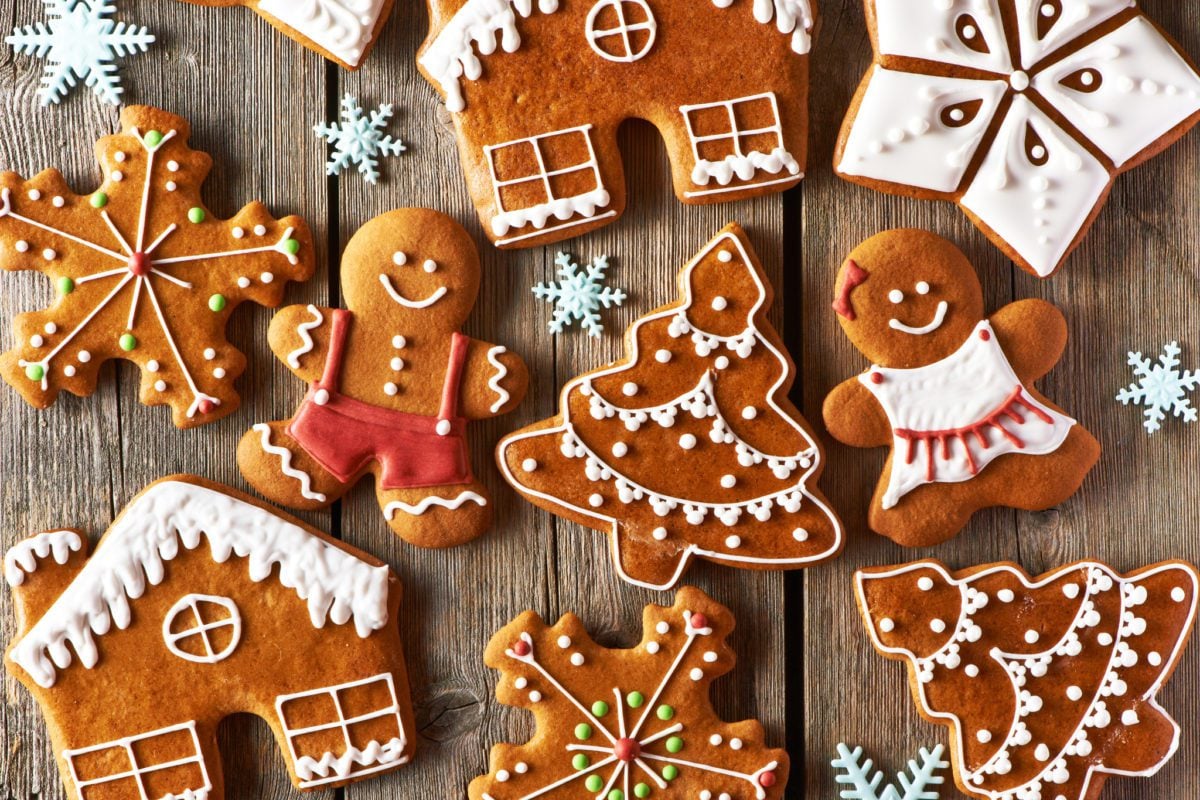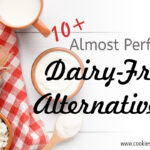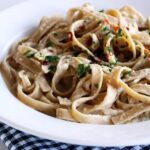Delight Santa and your guests with these delectable dairy-free Christmas cookies! This guide dives into creating three festive favorites – gingerbread, sugar cookies, and shortbread – all without compromising on flavor or texture. We’ll explore various dairy-free milk alternatives, ingredient substitutions, and creative decorating ideas to ensure your cookies are not only delicious but also visually stunning. Learn how to source high-quality ingredients, master the perfect cookie dough consistency, and even create your own dairy-free butter. We’ll cover everything from adapting recipes for other dietary needs to crafting beautiful, sustainable packaging for gifting.
Discover the secrets to achieving perfectly crisp edges, soft centers, and irresistible flavors in your dairy-free Christmas cookies. This comprehensive guide provides detailed recipes, step-by-step instructions, and visually appealing tables to simplify the process and inspire your holiday baking. Whether you’re a seasoned baker or a novice in the kitchen, these recipes are designed to be accessible and enjoyable for everyone.
Recipe Variations
Dairy-free Christmas cookies offer a delightful alternative for those with lactose intolerance or following a plant-based diet, without compromising on festive flavor or texture. This section explores three classic Christmas cookie recipes adapted for dairy-free baking, highlighting the nuances of different dairy-free milk alternatives and their impact on the final product. We’ll examine gingerbread, sugar cookies, and shortbread, comparing their unique textures and flavor profiles.
Dairy-Free Gingerbread Cookies
These cookies offer a warm, spicy flavor profile perfect for the holiday season. The molasses adds a rich depth, while the ginger, cinnamon, and cloves create a comforting aroma. Using a dairy-free butter alternative ensures a tender crumb.
Ingredients:
- 1 cup dairy-free butter, softened
- ¾ cup molasses
- 1 cup granulated sugar
- 1 large egg
- 4 cups all-purpose flour
- 2 teaspoons baking soda
- 1 teaspoon ground ginger
- 1 teaspoon ground cinnamon
- ½ teaspoon ground cloves
- ½ teaspoon salt
Instructions:
- Preheat oven to 350°F (175°C). Line baking sheets with parchment paper.
- In a large bowl, cream together the softened dairy-free butter and sugar until light and fluffy.
- Beat in the egg and molasses until well combined.
- In a separate bowl, whisk together the flour, baking soda, ginger, cinnamon, cloves, and salt.
- Gradually add the dry ingredients to the wet ingredients, mixing until just combined. Do not overmix.
- Roll out the dough to ¼ inch thickness on a lightly floured surface. Use cookie cutters to cut out desired shapes.
- Place cookies on prepared baking sheets and bake for 8-10 minutes, or until edges are lightly golden.
- Let cookies cool on baking sheets for a few minutes before transferring to a wire rack to cool completely.
Dairy-Free Sugar Cookies
These cookies provide a blank canvas for festive decorating. Their delicate sweetness and smooth texture make them ideal for intricate designs and vibrant icing. The use of dairy-free milk alternatives will subtly affect the texture.
Ingredients:
- ½ cup dairy-free butter, softened
- ½ cup granulated sugar
- 1 large egg
- 2 ½ cups all-purpose flour
- ½ teaspoon baking powder
- ¼ teaspoon salt
- ¼ cup dairy-free milk (almond, soy, or oat)
Instructions:
- Preheat oven to 375°F (190°C). Line baking sheets with parchment paper.
- In a large bowl, cream together the softened dairy-free butter and sugar until light and fluffy.
- Beat in the egg until well combined.
- In a separate bowl, whisk together the flour, baking powder, and salt.
- Gradually add the dry ingredients to the wet ingredients, alternating with the dairy-free milk, mixing until just combined.
- Roll out the dough to ⅛ inch thickness on a lightly floured surface. Use cookie cutters to cut out desired shapes.
- Place cookies on prepared baking sheets and bake for 8-10 minutes, or until edges are lightly golden.
- Let cookies cool on baking sheets for a few minutes before transferring to a wire rack to cool completely.
Dairy-Free Shortbread Cookies
These cookies boast a melt-in-your-mouth texture and buttery flavor. Their simplicity is their charm, making them a perfect base for a dusting of powdered sugar or a drizzle of melted dairy-free chocolate.
Ingredients:
- 1 cup dairy-free butter, cold and cubed
- ½ cup powdered sugar
- 2 cups all-purpose flour
- Pinch of salt
Instructions:
- Preheat oven to 325°F (160°C). Line baking sheets with parchment paper.
- In a large bowl, cut the cold dairy-free butter into the powdered sugar using a pastry blender or your fingers until the mixture resembles coarse crumbs.
- Gradually add the flour and salt, mixing until the dough just comes together. Do not overmix.
- Press the dough into a 1-inch thick rectangle on a lightly floured surface. Cut into desired shapes.
- Place cookies on prepared baking sheets and bake for 15-20 minutes, or until edges are lightly golden.
- Let cookies cool on baking sheets for a few minutes before transferring to a wire rack to cool completely.
Comparison of Dairy-Free Cookie Types
The impact of different dairy-free milk alternatives (almond, soy, oat) is subtle but noticeable, primarily affecting the texture and moisture content of the cookies. Almond milk might lend a slightly nutty flavor and a slightly drier crumb to sugar cookies, while soy milk could result in a denser texture. Oat milk may add a subtle sweetness and a slightly chewier consistency. These differences are minimal, however, and any of these milk types will work well.
| Cookie Type | Key Ingredients | Preparation Time | Baking Temperature (°F) |
|---|---|---|---|
| Gingerbread | Dairy-free butter, molasses, spices | 30 minutes | 350 |
| Sugar Cookies | Dairy-free butter, sugar, dairy-free milk | 25 minutes | 375 |
| Shortbread | Dairy-free butter, powdered sugar, flour | 20 minutes | 325 |
Ingredient Sourcing and Substitutions

Crafting dairy-free Christmas cookies that rival their traditional counterparts requires careful consideration of ingredient substitutions. The right choices will ensure both delicious flavor and the desired texture, transforming your holiday baking into a delightful experience. Understanding the properties of various dairy-free alternatives is key to achieving success.
Choosing the right dairy-free substitutes significantly impacts the final product. Butter, milk, and cream cheese each play unique roles in cookie baking, and their replacements must mimic these roles effectively. Sourcing high-quality ingredients is also paramount for achieving the best possible taste and texture.
Dairy-Free Butter Substitutes
Several excellent alternatives to butter exist for dairy-free baking. These substitutes vary in their flavor profiles and how they impact the final texture of the cookies. Careful selection is key to achieving optimal results.
- Vegan Butter: Many brands offer vegan butter sticks specifically designed for baking. These often have a similar texture and melting point to dairy butter, resulting in cookies with a tender crumb and rich flavor. Look for brands with high fat content for optimal results. Imagine a golden-yellow stick, smooth and easily spreadable, offering a buttery aroma when warmed.
- Coconut Oil: A solid, white fat at room temperature, coconut oil melts beautifully and imparts a subtle coconut flavor that can complement certain cookie recipes. However, it can also result in a slightly denser, chewier cookie than butter. Picture a white, opaque solid that transforms into a clear, fragrant liquid when heated.
- Avocado Oil: This oil has a high smoke point and a neutral flavor, making it a versatile option for baking. It results in cookies with a tender crumb but may not provide the same richness as butter or coconut oil. Visualize a vibrant green oil, smooth and fluid, with a mild, almost imperceptible scent.
Dairy-Free Milk Substitutes
Milk’s role in baking is multifaceted, affecting both texture and moisture. Choosing the right dairy-free milk is crucial for achieving the desired outcome in your Christmas cookies.
- Soy Milk: A widely available and versatile option, soy milk can be used in many recipes without significantly altering the flavor. However, its slightly beany taste might be noticeable in delicate cookies. Picture a creamy, off-white liquid with a mild, subtly sweet flavor.
- Almond Milk: With its nutty flavor, almond milk can add a unique dimension to cookies. Unsweetened varieties are best for baking to avoid overly sweet results. Imagine a pale, slightly milky-colored liquid with a delicate, nutty aroma.
- Oat Milk: Oat milk offers a creamy texture and a slightly sweet flavor that can work well in many cookie recipes. It adds moisture and helps create a tender crumb. Visualize a creamy, off-white liquid, slightly thicker than almond milk, with a mild, subtly sweet oat flavor.
Dairy-Free Cream Cheese Substitutes
Cream cheese provides richness and tang to many cookies. Fortunately, several delicious dairy-free alternatives exist.
- Tofutti Cream Cheese: This commercially available vegan cream cheese is a popular choice for its creamy texture and tangy flavor, closely resembling traditional cream cheese. Picture a smooth, white spreadable cheese with a slightly tangy aroma.
- Cashew Cream Cheese (Homemade): Soaking cashews and blending them with lemon juice and other seasonings creates a creamy, tangy spread that works well as a dairy-free cream cheese substitute. This offers complete control over ingredients and allows for customization of flavor. Imagine a smooth, ivory-colored spread with a slightly nutty and tangy aroma.
Sourcing High-Quality Dairy-Free Ingredients
Reading labels meticulously is crucial. Pay close attention to ingredient lists, looking for hidden dairy or other allergens. Choose brands known for high-quality ingredients and transparent labeling. Seek out specialty stores or online retailers that cater to vegan or allergy-friendly diets for a wider selection of products.
Making Your Own Dairy-Free Butter Alternative
While store-bought alternatives are convenient, making your own dairy-free butter allows for complete control over ingredients and flavor.
- Ingredients: 1 cup raw cashews, 1/2 cup water, 1/4 cup coconut oil, 1 tablespoon lemon juice, 1/2 teaspoon salt.
- Instructions: Soak cashews in hot water for at least 30 minutes to soften them. Drain and rinse the cashews. Combine all ingredients in a high-speed blender and blend until completely smooth and creamy. The mixture should resemble the consistency of butter. Imagine a creamy, off-white mixture that transitions from chunky to completely smooth as it is blended.
- Storage: Store the homemade dairy-free butter in an airtight container in the refrigerator for up to a week. Visualize a smooth, off-white spreadable substance stored in a sealed container.
Decoration and Presentation
Transforming your dairy-free Christmas cookies into edible works of art is half the fun! Careful decoration and presentation not only elevate the taste experience but also add a touch of festive magic, making them truly irresistible, even to Santa himself. Consider the overall aesthetic – a cohesive color palette and consistent decorating style will create a stunning visual impact.
Three creative ways to decorate dairy-free Christmas cookies to appeal to Santa involve incorporating diverse frosting techniques, edible decorations, and color schemes that capture the spirit of the season.
Creative Cookie Decorating Ideas
These three approaches showcase the versatility of dairy-free baking and offer a range of skill levels, from simple to intricate. Each design emphasizes visual appeal and festive cheer.
| Design | Frosting Technique | Edible Decorations | Color Palette | Image Description |
|---|---|---|---|---|
| Classic Christmas | Simple royal icing flood, piped Artikels | Red and green sprinkles, miniature candy canes, small gumdrops | Deep red, bright green, crisp white | Imagine a round sugar cookie, flooded with bright red icing. A crisp white Artikel encircles it, and small green gumdrops are arranged in a wreath-like pattern on top. Red and green sprinkles add a festive touch. |
| Winter Wonderland | Buttercream frosting swirls, piped snowflakes | Silver dragees, edible glitter, white chocolate shavings | Powder blue, silver, white | Picture a rectangular shortbread cookie delicately frosted with swirls of pale blue buttercream. Intricate piped white snowflakes adorn the surface, sprinkled with silver dragees and edible glitter for a shimmering effect. |
| Gingerbread Village | Brown sugar cookie icing, piped details | Pretzel sticks, gumdrops, mini marshmallows | Warm browns, ivory, pops of red | Envision a larger gingerbread-style cookie, iced in a rich brown. Pretzel sticks form miniature fences, gumdrops become colorful houses, and mini marshmallows add snowy rooftops. Details are meticulously piped in ivory icing. |
Festive Cookie Packaging for Gifting
Sustainable and reusable packaging adds a thoughtful touch to your homemade gifts. This guide details the process of creating beautiful and eco-friendly cookie containers.
- Choose your containers: Opt for reusable tins, attractive cardboard boxes, or even repurposed jars. Avoid single-use plastics.
- Add a layer of protection: Line your containers with parchment paper or biodegradable cellophane to prevent cookies from sticking or getting crushed.
- Arrange the cookies: Carefully place the cookies in the container, ensuring they are not stacked too high to prevent breakage.
- Add festive touches: Use natural twine or ribbon to tie the containers closed. Include a small handwritten tag with a personalized message or a recipe card.
- Consider presentation: Wrap the containers in festive fabric or kraft paper for an extra layer of charm and protection during transport.
This holiday season, spread joy and deliciousness with these dairy-free Christmas cookies. From the warm spice of gingerbread to the delicate sweetness of shortbread, each recipe offers a unique sensory experience. Remember, careful ingredient selection and attention to detail are key to achieving the perfect texture and flavor. With a little creativity and these easy-to-follow instructions, you can create a batch of cookies that Santa himself would approve of – and your guests will adore! Enjoy the process, and happy baking!
FAQ Summary
Can I freeze dairy-free cookies?
Yes, you can freeze both baked and unbaked dairy-free cookies. For best results, freeze them individually on a baking sheet before transferring to a freezer bag to prevent sticking.
How long do dairy-free cookies stay fresh?
Properly stored in an airtight container at room temperature, dairy-free cookies will generally stay fresh for 3-5 days.
What if I don’t have a specific dairy-free milk alternative listed?
Experiment! Many plant-based milks work well, but results may vary slightly in texture. Start with a similar milk type (e.g., if the recipe calls for almond milk, try another nut milk).
Are these cookies suitable for all ages?
Yes, provided you carefully check for any additional allergies in your chosen ingredients and adapt the recipe accordingly. Always supervise young children while baking and decorating.


